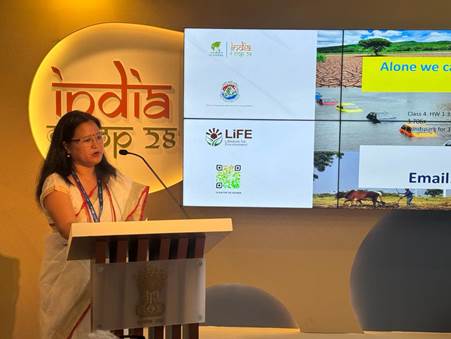During the COP 28 climate summit, the India pavilion served as a platform for in-depth discussions on the far-reaching impacts of climate change in the Himalayan region. Participants explored strategies for fostering ‘Climate Resilient Development in the Indian Himalayan Region’ by emphasizing the importance of making mountain communities environmentally sustainable and resilient.
Within the pavilion, delegates engaged in dialogues concerning India’s ongoing climate change initiatives and emphasized the urgent need for immediate action in the face of escalating climate challenges. India highlighted key aspects such as the Climate Change Programme (CCP) under the National Action Plan on Climate Change of the Government of India, vulnerability and risk assessment in India, regional perspectives on the Cryosphere, climate risk profiles for adaptation plans in Manipur state, and inclusive climate actions for the sustainable development of the Indian Himalayan Region (IHR).
Himalayan Initiatives
The Ministry of Environment, Forest, and Climate Change, under the Government of India, has spearheaded various initiatives aimed at safeguarding and developing the Indian Himalayan Region (IHR). The Central Sector Grant-in-aid Scheme on the National Mission on Himalayan Studies focuses on addressing key issues related to the conservation, enhancement, and sustainable management of natural resources in the IHR.
The Department of Science and Technology has also been actively supporting the Himalayan Environmental Studies and Conservation Organization to rejuvenate the health of the Himalayas by integrating research into conservation efforts.
The National Mission for Sustaining the Himalayan Ecosystem (NMSHE), launched as part of the National Action Plan on Climate Change (NAPCC), plays a crucial role in enhancing understanding about the linkages between climate change and the Himalayan ecosystem for more effective adaptation. State Climate Change Centres in Himalayan States/UTs, a part of NMSHE, focus on climate vulnerability assessments, public awareness campaigns, and training and capacity building for climate change adaptation planning.
Moreover, NMSHE strives to develop and adopt innovative methods for assessing the health of the Himalayan ecosystem, including glaciers, and establishing a comprehensive database. The Climate Vulnerability and Risk Assessment for the Himalayan region concentrate on identifying vulnerabilities and risks posed to the Himalayas due to climate change.










